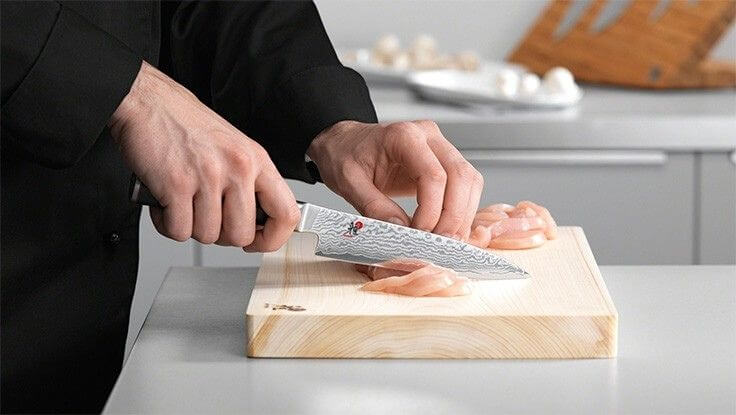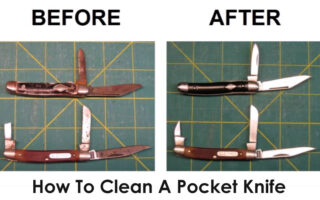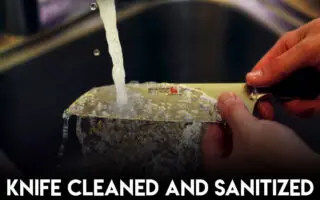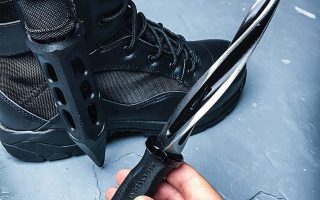Knife Handling Tips To Avoid Cuts
Using a kitchen knife is quite tricky and not a very easy job as it seems. There are many techniques of holding the knife and cutting with it. You can’t just hope to have a safe go with a sharp knife without following each of these rules. However, here in this article we will be describing you the proper way of handling a kitchen knife, how to hold it and how to apply it properly.
Handling a kitchen knife is not something unworthy to learn. It’s highly important for the safety of you and for the children at home. There are so many aspects of handling a kitchen knife.
There are five main themes behind a safe knife handling session. And all of these are important if you want to get the best outcome from your new shinny knife. Here are few tips to Prevent Cuts in Kitchen.
1. Use A Sharp Knife
No matter how busy you are, never underestimate the importance of sharping the knife. Always use a sharp knife for whatever you are cutting. Using a dull knife can become your worst nightmare. A recent study says, more than 70% of knife accidents occurs due to the high using rate of dull knife. Sharpening your knife will take only 5 to 10 minutes. Don’t just skip the step to safe some minutes. That apart, a sharp knife is also time efficient. You will be able to cut the elements smooth and easy without putting much pressure or effort. Dull knives takes extra effort to operate.
2. Hold the Knife Perfectly
Here comes the most important part of the job. Holding the knife perfectly is the most important part of having a safe and great knife handling session. There are multiple methods of holding a knife. We are going into details as it is the most important matter to focus on and can’t be neglected.
How to Hold a Knife
The cutting hand is the main operator in the game. However, the other hand will work as a great supporting player. The helping hand will stabilize, move and rotate the elements and help to complete the job. When you will learn the use of the two hands and the knife with the perfect combination of these three, the job will be much easier for you. Grip is the most important topic to describe.
The Grip
The grip style differs depending on the situation. While you are chopping something, the grip will be quite firm and easy. The thumb should be at one side of the handle and the other 4 fingers will be on the other side. Hold it firmly, not too tight not too loose. When you are slicing something, let’s suppose an apple, the best way to grip the knife will be quite different from the previous method. Take your index finger at the top edge of the knife, pointing to the front. And hold the handle with the other fingers. put pressure and slice the apple or mango, whatever it it. Point to remember, when the element is bigger than average than you might need to hold the handle in chopping style rather than slicing style.
The Helping Hand
The helping hand plays a very important role in both slicing and chopping. There are two different methods of placing the helping hand while cutting with the knife.
While slicing something, the helping hand can be on one side of the material or it can be on the top of the knife bridge, touching the two corner of the material without touching the knife bridge.
While Chopping the helping hand can be places in the last corner of the element. Make sure you keep your hand far enough from the blade.
3. Choose The Right Knife
There are lots of knife categories and the purposes of using those knives are different. You can’t chop a big piece of meat with a six inches knife, at the same time, slicing a small piece of fruit with a big knife will be a little bit uncomfortable. The best idea is to use the knife in the particular way what it was made for. There are some things you need to consider while choosing the right knife for your task. Among them the blade is the most important aspect. The quality and type of the blades should differ according to the purpose of your work. However, below we have mentioned all the topics that you need to consider about the blade, before you get into the work.
The Blade Size
As we mentioned before, You can’t butch a big piece of meat with a small knife. Prefer a bigger knife with a length of 10 inches if you are into chopping or butchering job. The smaller knives will do the slicing job perfectly. Don’t mix up the chopping knife with the slicing one. It may damage the blade permanently.
Blade Flexibility
There are certain tasks that require flexible blades while the other tasks require firm ones. Identify the task you are approaching to, and then choose the ideal knife that matches your purpose. The knife you need for removing scales from the fish will be quite different from the one that is required to cut potatoes. Using the ideal knife for your particular job will give you extra comfort and smoothness.
Blade Edge
The edge of the blade is the most important element of the whole system. There are some knives with a double edge blade, that you can use to cut anything with each size rotated. The other knives have only one sharped edge. You need to cut with that particular side. There are also some blade types that can cut the wet things swiftly and the other blades are good at cutting the hard materials.
Never cut anything else with the knife that you are using to cut food items. That will spoil the hygiene and will also be the reason of the blade being damaged.
4. Apply Proper Cutting Techniques
Knowing the proper cutting techniques is one of the most important and the fundamental part of knife safety. Wrong techniques may cause severe injury. Also holding the knife incorrectly can decrease the quality of work and the cut might not be as proper as expected. However, There are some essential points you need to be introduced to. Here they are:
- Always use a cutting board as a hard surface. It will give you extra comfort and will feel the vibe after each cut ends.
- Take a firm grip with your cutting hand. The grip should not be extended. Don’t grip the handle too close to the blade or at the end of the handle. Grip it in the middle.
- While slicing, use the index finger as a pointer finger. This will give you extra balance and control while cutting.
- Use your helping hand properly. Place the helping hand in the ideal manner. The placement depends on what you are cutting. If you are copping something the hand should be placed beside the material. While slicing the hand should be garbing the element firmly.
For a safe cutting session, follow all the instructions above. These techniques are recommended by the professionals and are proven to be effective.
5. Pay Attention to Your Work
There are a lot of people who likes to do work while talking or gossiping with friends. You will see a lot of people talking over phone while cutting a piece of fruit. They hold the cell phone with the shoulder and ended up cutting their finger or even worse. This is the most irresponsible work you will ever do. Hence, You kids are around you they will learn everything from you. You should act responsible in front of them. If they see you cutting something with a knife in a wrong manner, they will think it’s not a very big deal. Finally they will not learn the ideal way of using a knife and you are responsible for that.
So concentrate on your work. Look what you are cutting. Don’t talk while cutting something. At least don’t move your sight from the cutting board. After you have finished, don’t put the knife away without washing them. Wash them properly with hot water and soap and store them in a safe place out of the children’s reach.
What is the risk of sharp knife?
The main danger of a sharp knife is getting cut, which will happen if the blade is not kept in proper working order. This can be dangerous as the tip of the blade can penetrate the skin and even cause damage to internal organs.
Conclusion
Handling a kitchen knife is easy, but a lot of people find it time costly. People don’t want to spend their valuable time in taking care of their knives which play a vital role in their daily life. A well built kitchen knife is the best friend of yours in the kitchen.
Why not take a little bit care to it and learn some tips and tricks on handling them. There are so many rules are terms about handling a kitchen knife perfectly. We have mentioned the most important ones. We hope you will follow all the tips and enjoy a happy cutting session without getting yourself a cut.

Hi, my name is Taras Kulakov and I’m a knife enthusiast. I have been collecting knives for over 30 years and I’ve owned literally thousands of different models over that time. My goal with this site is to share some of what I’ve learned about knives. You can find more info about Taras Kulakov here.




